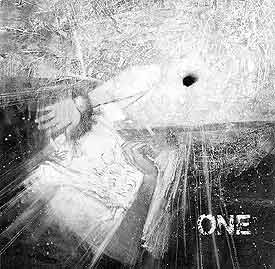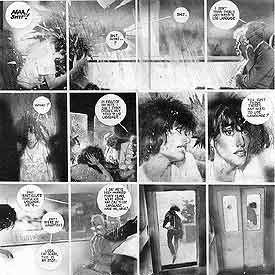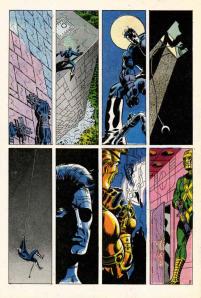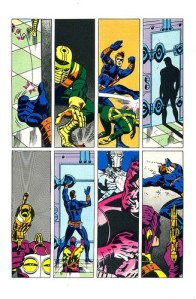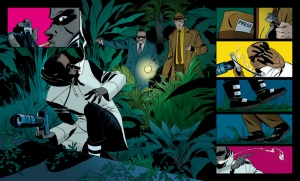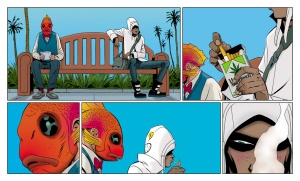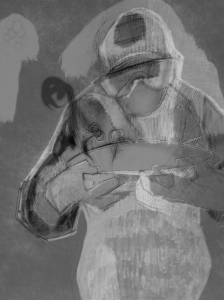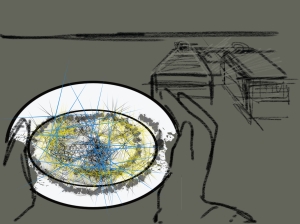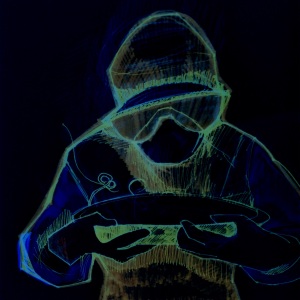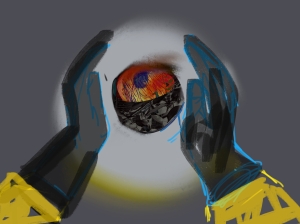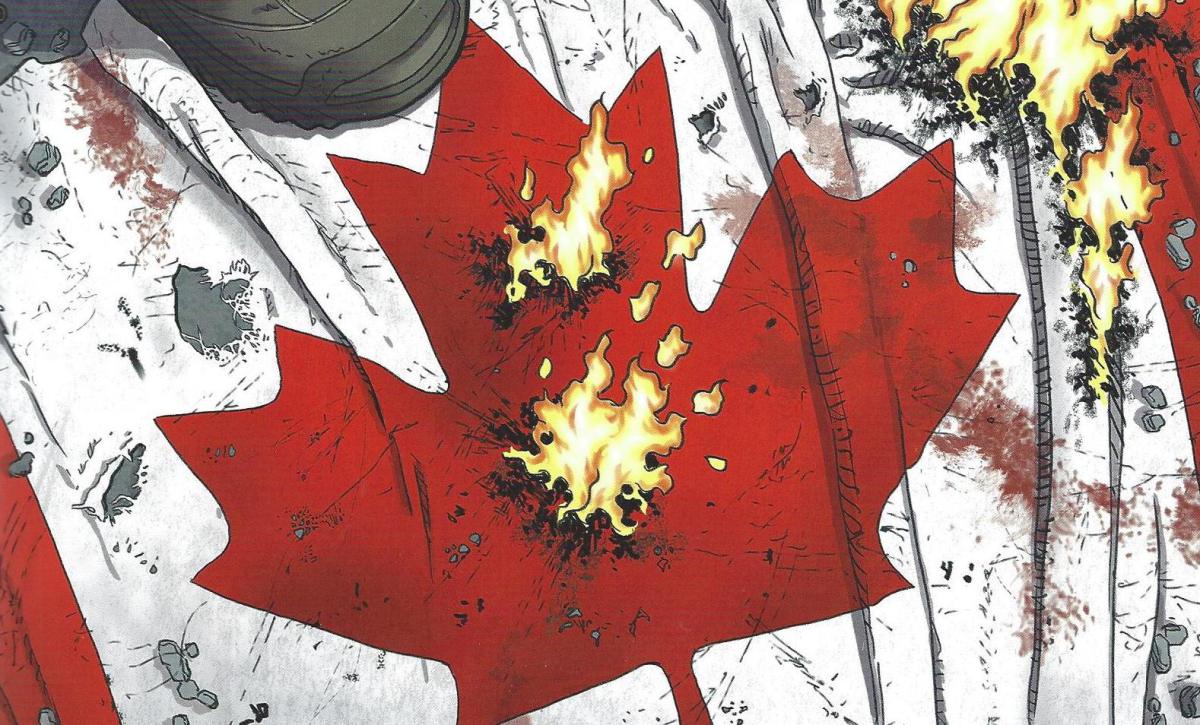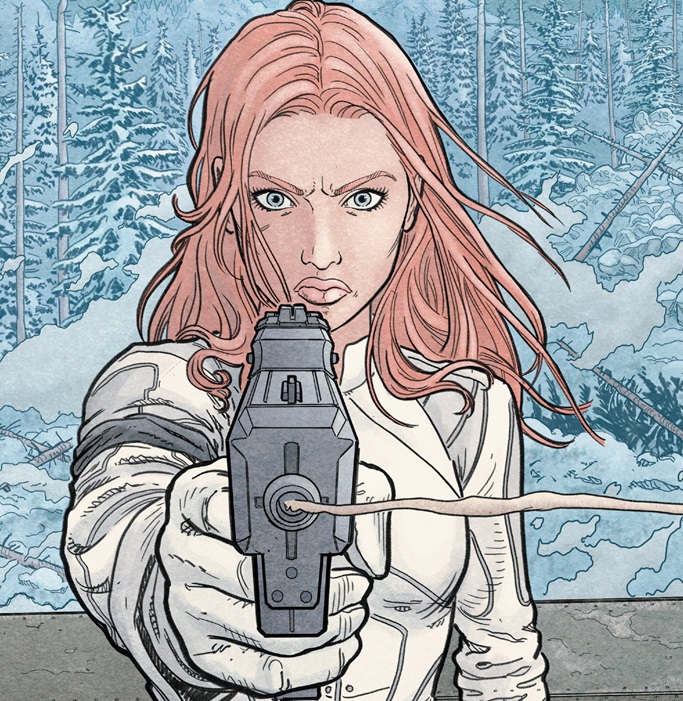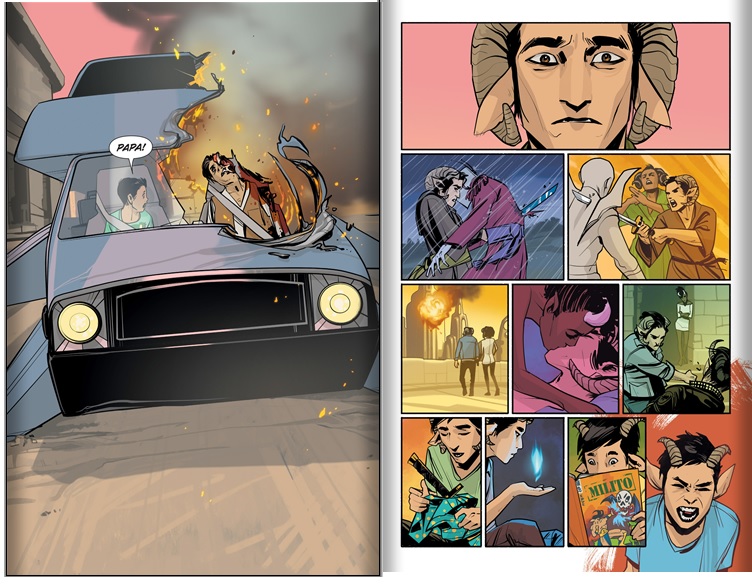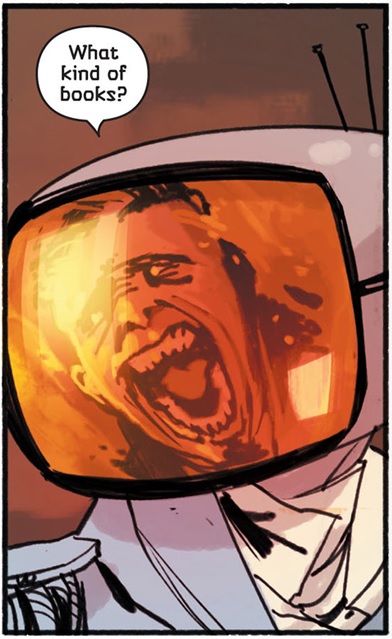What people forget, of course, when they’re confronted with a graphic novel about four lions who look suspiciously like the characters in Disney’s The Lion King is that Pride of Baghdad is indeed based on a true story. It is a comic relatively free of humans, following four lions who escape from the Baghdad Zoo after the initial U.S. bombing campaign, tracing how they evolve in their understandings of freedom, place, and community. Their escape is a surprise (they are released when U.S. bombs blow apart their cages), but each lion reacts to this new-found freedom differently. Noor is delighted—she has been planning an escape for months—but worries that freedom that one doesn’t work for isn’t truly freedom. Safa, on the other hand, was a victim of gang-rape while she was still in the wild, and has no interest in returning to the chaos she perceives as reigning beyond the walls of the zoo. Zill, while he tells nostalgic stories about the sunrises in the wild, largely seems ambivalent about the prospect of freedom; he would like more control, but he also likes being fed regularly. Ali, the cub, is largely unaffected as well. What follows is how I approach explaining to students the relative use of Pride of Baghdad in understanding the variety of positions one may take in regards to the Iraq War.
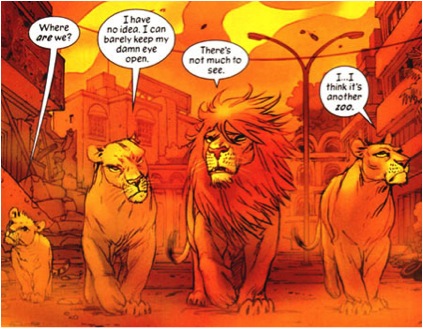
Zill and Noor both long to return to the freedom they had as cubs, although they approach this in different ways. While Zill indulges in nostalgia, he doesn’t seek freedom, and their liberation seems barely to affect his attitude. Noor, on the other hand, is actively attempting to craft an escape plan. However, once they are free, Noor shows herself to be capable as a huntress, but is psychologically ill-prepared for freedom. Safa, unlike the other two adult lions, appreciates the zoo for the safety and consistency it provides. After the escape, Safa adapts back to the unpredictability of the larger world swiftly, but she is physically no longer capable of being the huntress she once was.
Each lion approaches the question of freedom from a different angle. Noor, while still inside of the zoo, thinks primarily of the physical bars on the cages as limitations on her freedom. For her, liberty is freedom of movement. Safa, in contrast, does not see freedom in terms of the ability to make choices about where she is. Liberty for Safa is defined by safety from outside threat. She sees the cages as protection, and a regular feeding schedule as safety.
For example, Safa could represent “staying at home” (i.e. staying out of foreign wars) as a preferable political stance. However, she could also represent the idea that safety can only occur with the sacrifice of certain liberties. Furthermore, she could represent a recognition of the negative potential for foreign intervention, but through her actions, she nonetheless intervenes for the good of her pride.
When I teach Pride of Baghdad, I first approach it considering who the lions represent.
It’s worth considering how they might connect to Iraqi civilians. America was the force that came into the country. Saddam was a brutal dictator. However, under his leadership, there was relative peace and stability for the vast majority of Iraqi civilians. They may or may not have liked living under his regime, but they were relatively safe from threat—unless, of course, you were unlucky enough to draw Saddam’s attention or to be a member of a religious sect or ethnic group he despised.
Consider the lion that Safa and Noor find in the palace. In this scene, we see the lion in his death throes, wasting away while chained within a palatial estate. We of course come to find out that the bear had been stealing his food, but the bear isn’t the only bad guy here. What was removed from that lion that was a part of him?
Teeth and claws—the vehicles of a sort of natural violence, evolved in order to survive, to fight and to eat prey. The chain isn’t the only thing holding him to the wall. The chain signifies something much more basic that has been stripped from him: the right to feed himself and to defend himself. His calls for his Master, the man who did this to him (presumably Saddam or one of his sons), gestures towards the extent to which a dictatorship may remove the most basic freedoms from its citizenry in the name of a particular version of safety.
Noor is immediately willing to hypothesize that this is indeed the end result of their captivity: the removal of the ability to live without the master. Safa, however, emphasizes the distinction between the compassion that the keepers showed and the brutality with which this animal was treated.
But how do we understand the bear’s interruption here? “Ungrateful whores,” he says. What is a whore? Why would this particular insult be used? The bear draws a relationship between this insult and the distinction between a prisoner and a pet. His name, “fajer,” is probably a corruption of “fajr,” which means “dawn,” but also has a related term that means “whore.” Why would the bear have been allowed to keep his teeth and claws when they were removed from the lion? Think in relation to expressions of capriciousness, the whim of the master as a guiding principle, rather than a stable set of laws by which one abides.
In relation to Pride of Baghdad, the value most clearly explicated is freedom, but what does freedom mean in the context of war?
On the other hand, the lions could represent American civilians’ debates in the lead-up to the war. It’s worth thinking about the pro- and anti-war camps in relation to Safa, Noor, and Zill. When is Safa violent? When she is convinced that her family is under threat. Safa is mostly concerned with maintaining her own safety, particularly because of her past. However, she doesn’t shy away from the prospect of protecting those who are weaker. Safa can be regarded as a stand-in for the American public—horrified and traumatized by 9/11, needing to reassert control over their own bodies and on the world stage.
That said, Noor, our revolutionary who wanted nothing more than freedom, finds that to a great extent, the boundaries of the zoo are not that dissimilar to the boundaries of life in the wasteland of a bombed city. No freedom exists without responsibility and without personal sacrifice of safety. In the aftermath of 9/11, the Patriot Act and other legal frameworks were established to “protect” American citizens, but did nothing so much as create a transparent cage.
When is Zill violent? Consider the page in which he attacks the bear—distinction between a hunter and a fighter. Hunting, as “women’s work” within the pride, denotes a division of labor. Hunting isn’t perceived as violence, but rather as the procurement of food—a simple necessity. Fighting is violence, but it also springs out of necessity for Zill, in reference to defending the females from the bear.
Of course, when we’re considering the causes for violence, we have to consider how we justify violence within our own lives. What is a “justified use of force”?
In general, we think of violence as being justified when it serves to protect. Violence used in the service of protecting the self or another is seen almost universally as a moral exertion of force. This leads us into the question of what constitutes a “just war.” Just wars are based on a set of criteria that must be established to prompt particular action, including a cause celebré of the protection of the self (the nation) or the protection of a significantly weaker force. Just war may be employed only when other avenues have been exhausted. Of course, a part of what this means is the protection of the ideals and values by which we live, and the ideals and values we believe are basic human rights.
Fables are remembered because they filter into our consciousness and give us a series of rules to follow. However, Pride of Baghdad takes the structure of a fable and breaks down the possibility of a particular rule. The lions are killed at the end. This would seem to suggest that, given our sympathetic engagement with the lions throughout the text, that the invasion was wrong, and that we should feel angry at our government for invading. But precisely what do we encounter along the way to that final scene that complicates our understanding?
When the lions are freed from the zoo, is that not (aside from Safa), what they most desire? Who frees them from the zoo? American bombs. Bombs, for Vaughan and Henrichon, have at least as much power to liberate as they do to destroy. However, the final scene shows a fundamental misunderstanding by the troops of the lions. Zill is simply sitting there, watching the horizon with his family, until he is suddenly killed.
The pride’s reaction is very understandable. They turn in anger at the enemy who has suddenly shattered this moment of calm. In the scene following the lions’ deaths, what don’t we see? Faces.
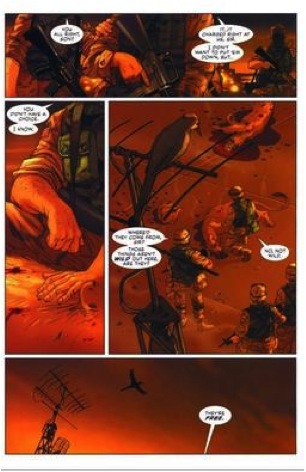
When you have an icon, the more abstracted it is from reality, the more opportunity you have to identify with it. The flag and the faceless soldiers both are icons through which we’re meant to identify—these are our troops, this is our war. When the soldier stutters that “It…it charged right at us, sir. I didn’t want to put ‘em down, but…” we may feel angry, or we may have a surge of sympathy for the young man suddenly thrust into the position of shooting these animals; we may feel his fear and confusion.
In regards to this, I also think of the lions. When we look at the lions, we see ourselves—they are mimicries of humanity —adjacent to us, but not precisely like us. They are like the Iraqi civilians, but so much closer to our experience through this metaphoric lens. While they have a different perception of the world based on their culture and their expectations about how the world works, they’re still excruciatingly present in their deaths, in a way that most casualties of war are not. When we look at a photograph of a crying mother or a dead man, we see them. But when we look through the prism of the fable, we see us. And in this reflection of ourselves, we see no easy answers as to right and wrong.
